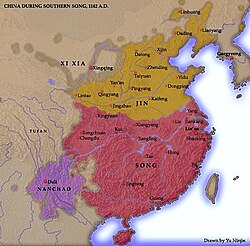Dali Kingdom
Great Li Dablit Guaif 大理國 | |||||||||
|---|---|---|---|---|---|---|---|---|---|
| 937–1095 1096–1253 | |||||||||
 Location of Dali (purple) in 1142 | |||||||||
| Capital | Dali | ||||||||
| Religion | Buddhism | ||||||||
| Government | Monarchy | ||||||||
| Emperor | |||||||||
• 937–944 | Duan Siping | ||||||||
• 1081–1094 | Duan Zhengming | ||||||||
• 1096–1108 | Duan Zhengchun | ||||||||
• 1172–1200 | Duan Zhixing | ||||||||
• 1251–1254 | Duan Xingzhi | ||||||||
| History | |||||||||
• Established | 937 937 | ||||||||
• Coup d'etat by Gao Shengtai | 1095 | ||||||||
• Reestablished | 1096 | ||||||||
• Ended by the Mongol Empire | 1253 1253 | ||||||||
| |||||||||
The Dali (Great Li) Kingdom or Dali State (Bai language: Dablit Guaif; simplified Chinese: 大理国; traditional Chinese: 大理國; pinyin: Dàlǐ Guó) was a kingdom centred in what is now Yunnan Province of China. Established by Duan Siping in 937, it was ruled by a succession of 22 kings until the year 1253, when it was conquered by an invasion of the Mongol Empire. The capital city was at Dali.
History
The Dali Kingdom was preceded by the Nanzhao dynasty, which was overthrown in 902. Three dynasties followed in quick succession, until Duan Siping seized power in 937 and established Dali.[1][2] Gao Shengtai forced the puppet king Duan Zhengming to abdicate and become a monk in 1095, and renamed the state Dazhong. He returned the power to the Duan family upon his death. Duan Zhengchun renamed the state Hou Li (literately "Later Li") in the next year.
Han Chinese ancestry was professed by the Duan clan.[3] Their Han ancestors originated from Wuwei in Gansu province 武威段氏.[4][5][6][7][8][9][10][11]
The 11th king of Nanzhao established Buddhism as the state religion. Ten of the 22 kings of Dali gave up the throne and became monks.[12]
It is claimed that despite their military prowess and superior numbers, the Mongols could not breach the defenses of the Erhai valley, which was so suited to defense that even just a few defenders could hold out for years. It is said that the Mongols found a traitor who led them over the Cangshan mountains along a secret path, and only in this way were they able to penetrate and overrun the Bai defenders. Thus ended three centuries of independence. In 1274 the Province of Yunnan was created by the Mongol Empire at the beginning of the Yuan dynasty.
Historians, however, relate that the "traitor" was the last king of Dali himself, who first fought and then surrendered to the forces of Kublai Khan, to be spared and later appointed by Möngke Khan (also known as Mengu) as the region's first Native Chieftain.[13]
The Dali King Duan Xingzhi himself defected to the Mongols, and helped them conquer the rest of Yunnan with his troops.[14]
King Duan Xingzhi of Dali was then enfeoffed as Maharaja (摩诃罗嵯) by the Yuan Emperor Kublai Khan,[15] and the Dali Kingdom Duan royal family continued to hold the title of Maharaja in Yunnan as vassals to the Mongols under the supervision of Mongolian imperial princes and Muslim governors (Sayyid Ajjal Shams al-Din Omar). After the Ming dynasty conquered Yunnan from the Yuan,[16] The Duan royals were scattered in various distant areas of China by the Hongwu Emperor.[17]
Dali kings family tree
| Dali kings family tree | |||||||||||||||||||||||||||||||||||||||||||||||||||||||||||||||||||||||||||||||||||||||||||||||||||||||||||||||||||||||||||||||||||||||||||||||||||||||||||||||||||||||||||||||||||||||||||||||||||||||||||||||||||||||||||||||||||||||||||||||||||||||||||||||||||||||||||||||||||||||||||||||||||||||||||||||||||||||||||||||||||||||||||||||||||||||||||||||||||||||||||||||||||||||||||||||||||||||||||||||||||||||||||||||||||||||||||||||||||||||||||||||||||||||||||||||||||||||||||||||||||||||||||||||||||||||||||||||||||||||||||||||||||||||||||||||||||||||||||||||||||||||||||||||||||||||||||||||||||||||||||||||||||||||||||||||||||||||||||||||||||||||||||||||||||||||||||||||||||||||||||||||||||||||||||||||||||||||||||||||||||||||||||||||||||||||||||||||||||||||||||||||||||||||||||||||||||||||||||||
|---|---|---|---|---|---|---|---|---|---|---|---|---|---|---|---|---|---|---|---|---|---|---|---|---|---|---|---|---|---|---|---|---|---|---|---|---|---|---|---|---|---|---|---|---|---|---|---|---|---|---|---|---|---|---|---|---|---|---|---|---|---|---|---|---|---|---|---|---|---|---|---|---|---|---|---|---|---|---|---|---|---|---|---|---|---|---|---|---|---|---|---|---|---|---|---|---|---|---|---|---|---|---|---|---|---|---|---|---|---|---|---|---|---|---|---|---|---|---|---|---|---|---|---|---|---|---|---|---|---|---|---|---|---|---|---|---|---|---|---|---|---|---|---|---|---|---|---|---|---|---|---|---|---|---|---|---|---|---|---|---|---|---|---|---|---|---|---|---|---|---|---|---|---|---|---|---|---|---|---|---|---|---|---|---|---|---|---|---|---|---|---|---|---|---|---|---|---|---|---|---|---|---|---|---|---|---|---|---|---|---|---|---|---|---|---|---|---|---|---|---|---|---|---|---|---|---|---|---|---|---|---|---|---|---|---|---|---|---|---|---|---|---|---|---|---|---|---|---|---|---|---|---|---|---|---|---|---|---|---|---|---|---|---|---|---|---|---|---|---|---|---|---|---|---|---|---|---|---|---|---|---|---|---|---|---|---|---|---|---|---|---|---|---|---|---|---|---|---|---|---|---|---|---|---|---|---|---|---|---|---|---|---|---|---|---|---|---|---|---|---|---|---|---|---|---|---|---|---|---|---|---|---|---|---|---|---|---|---|---|---|---|---|---|---|---|---|---|---|---|---|---|---|---|---|---|---|---|---|---|---|---|---|---|---|---|---|---|---|---|---|---|---|---|---|---|---|---|---|---|---|---|---|---|---|---|---|---|---|---|---|---|---|---|---|---|---|---|---|---|---|---|---|---|---|---|---|---|---|---|---|---|---|---|---|---|---|---|---|---|---|---|---|---|---|---|---|---|---|---|---|---|---|---|---|---|---|---|---|---|---|---|---|---|---|---|---|---|---|---|---|---|---|---|---|---|---|---|---|---|---|---|---|---|---|---|---|---|---|---|---|---|---|---|---|---|---|---|---|---|---|---|---|---|---|---|---|---|---|---|---|---|---|---|---|---|---|---|---|---|---|---|---|---|---|---|---|---|---|---|---|---|---|---|---|---|---|---|---|---|---|---|---|---|---|---|---|---|---|---|---|---|---|---|---|---|---|---|---|---|---|---|---|---|---|---|---|---|---|---|---|---|---|---|---|---|---|---|---|---|---|---|---|---|---|---|---|---|---|---|---|---|---|---|---|---|---|---|---|---|---|---|---|---|---|---|---|---|---|---|---|---|---|---|---|---|---|---|---|---|---|---|---|---|---|---|---|---|---|---|---|---|---|---|---|---|---|---|---|---|---|---|---|---|---|---|---|---|---|---|---|---|---|---|---|---|---|---|---|---|---|---|---|---|---|---|---|---|---|---|---|---|---|---|---|---|---|---|---|---|---|---|---|---|---|---|---|---|---|---|---|---|---|---|---|---|---|---|---|---|---|---|---|---|---|---|---|---|---|---|---|---|---|---|---|---|---|---|---|---|---|---|---|---|---|---|---|---|---|---|---|---|---|---|---|---|---|---|---|---|---|---|---|---|---|---|---|---|---|---|---|---|---|---|---|---|---|---|---|---|---|---|---|---|---|---|---|---|---|---|---|---|---|---|---|---|---|---|---|---|---|---|---|---|---|---|---|---|---|---|---|---|---|---|---|---|---|---|---|---|---|---|---|---|---|---|---|---|---|---|---|---|---|---|---|---|---|---|
| |||||||||||||||||||||||||||||||||||||||||||||||||||||||||||||||||||||||||||||||||||||||||||||||||||||||||||||||||||||||||||||||||||||||||||||||||||||||||||||||||||||||||||||||||||||||||||||||||||||||||||||||||||||||||||||||||||||||||||||||||||||||||||||||||||||||||||||||||||||||||||||||||||||||||||||||||||||||||||||||||||||||||||||||||||||||||||||||||||||||||||||||||||||||||||||||||||||||||||||||||||||||||||||||||||||||||||||||||||||||||||||||||||||||||||||||||||||||||||||||||||||||||||||||||||||||||||||||||||||||||||||||||||||||||||||||||||||||||||||||||||||||||||||||||||||||||||||||||||||||||||||||||||||||||||||||||||||||||||||||||||||||||||||||||||||||||||||||||||||||||||||||||||||||||||||||||||||||||||||||||||||||||||||||||||||||||||||||||||||||||||||||||||||||||||||||||||||||||||||
References
- ^ Alfred Schinz (1989). Cities in China. G. Borntraeger. p. 302. ISBN 3-443-37009-8. Retrieved 15 May 2011.
- ^ http://www.gutenberg-e.org/yang/chapter3.html
- ^ Frederick W. Mote (2003). Imperial China 900-1800. Harvard University Press. pp. 710–. ISBN 978-0-674-01212-7.
- ^ http://blog.cntv.cn/11002754-787613.html
- ^ http://th.yuxinews.com/xs/jtly/13560.shtml
- ^ http://www.wuweinew.com/NewsList.asp?ID=2129
- ^ http://paper.yunnan.cn/html/20060519/news_89_144905.html
- ^ http://www.lishifengyun.com/shiqianrewu/wudaishiguo/2990.html
- ^ http://qcyn.sina.com.cn/news/yzjd/2012/0809/16583890498.html
- ^ http://familytree.netor.com/?no=918
- ^ http://dl.ynpost.com/MLDL/RWDL/200710/7401.html
- ^ "Nanzhao State and Dali State". City of Dali.
- ^ Du Yuting; Chen Lufan (1989). "Did Kublai Khan's Conquest of the Dali Kingdom Give Rise to the Mass Migration of the Thai People to the South?" (free). Journal of the Siam Society. JSS Vol. 77.1c (digital). Siam Heritage Trust: 2–4. Retrieved March 17, 2013.
... Duan Xingzhi, the king of the Dali Kingdom, who originally showed resistance but later was willing to surrender, was bought over and made use of. As a result, the measures taken by the Mongolian aristocracy towards the king of the Dali Kingdom rapidly took effect. In 1255 and 1256 Duan Xingzhi was presented at court, offering Mengu ... maps of Yunnan and counsels about the vanquishing of the tribes who had not yet surrendered....
{{cite journal}}: line feed character in|quote=at position 39 (help) - ^ http://www.siamese-heritage.org/jsspdf/1981/JSS_077_1c_DuYutingChenLufan_KublaiKhanConquestAndThaiMigration.pdf
- ^ http://www.gutenberg-e.org/yang/chapter5.html
- ^ Frederick W. Mote; Denis Twitchett (26 February 1988). The Cambridge History of China: Volume 7, The Ming Dynasty, 1368-1644. Cambridge University Press. pp. 144–. ISBN 978-0-521-24332-2.
- ^ http://www.gutenberg-e.org/yang/chapter4.html
External links
 Media related to Kingdom of Dali at Wikimedia Commons
Media related to Kingdom of Dali at Wikimedia Commons
